Valleys / Recreational Areas
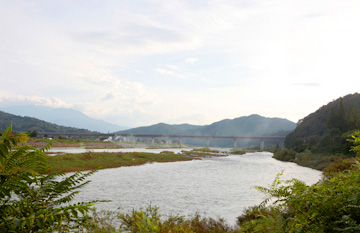
If you are seeking to escape the exhaustion of urban life in the midst of the sultry summer, and to spend time in a relaxing and cooling place with beautiful scenery and refreshing, clear air, we recommend you head on out to the Gangjeong Recreation Area. Gangjeong Recreation Area is located in Saengcho-myeon, Eoseo-ri, and is a scenic site that was officially recognized as a naturally formed recreational area in 1992.
The water of the Imcheon Stream , which originates from the northern regions of Jirisan Mountain and flows past Macheon, and the waters of Namgye and Wicheon Stream, which flow south from Deogyusan Mountain and merge to form Noegye, converge at this site.
Gangjeong is a natural recreational area famed for its clear waters and scenic beauty, frequented by numerous summertime visitors who come to sunbathe in the sandy beaches formed by the two branches of flowing water and cool themselves in the refreshing river.
The total area of the Gangjeong Recreation Area is 3,130㎡, and it offers access to an abundance of nearby attractions such as scenic Taebongsan Mountain, Galjeonsan Mountain with its stunning views, the Saengcho International Sculpture Park, the Saengcho Ancient Tombs, Wangsan Mountain with its first-class hiking trails, Pilbongsan Mountain, Deogyangjeon Hall, and the Royal Tomb of King Guhyeong. It is a great place to visit with beloved family members to enjoy the tourist attractions in the vicinity. We recommend bringing children down during the vacation months to learn the history of Sancheong and the wonders of nature. Rebuild your bond with friends by spending time frolicking in the cool river water, or spend an unforgettable romantic date with your beloved in the picturesque setting.
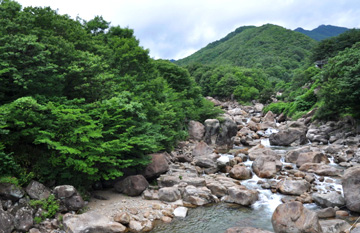
Georim Valley as a whole refers to the grand valley formed by the convergence of the main Georim valley, which originates in Seseokpyeongwon (an area renowned as the 4th of the Ten Scenic View of Jirisan Mountain due to its gorgeous azaleas), Dojanggol Valley, which begins in Yeonhabong Peak and Chotdaebong Peak (peaks located along the main ridge of Jirisan Mountain), and Jappajingol Valley, which originates in Hanbeotsaem Spring (located along the ridge that runs from Seseokpyeongwon to Samsinbong Peak).
The length of the main pass of Georim Valley alone is around 30km, and in the springtime, when the azaleas are in bloom, their beauty attracts such a crowd that the noise of the hiker’ steps are enough to drown out the sound of flowing water in the valley. To get there, travel in the direction of Jungsalli from Deoksan, Sicheon-myeon, Sancheong-gun and then turn left at the Gokjeom Village Samgeori. Many hiking aficionados prefer to climb to Jappajingol Valley or Chotdaebong Peak along the southern ridge in Dojanggol Valley, rather than hike in Georim Valley, where the landscape may strike hikers as bland and unadventurous as one’s neighborhood hillside. The valley along the southern ridge is called ‘”Jappajingol Valley” or “Eopeojin Tteul,” which refers to how the slopes in this area have a low incline as though it has been flopped down or has been tipped over. The scenic beauty of the valley, however, is second to none.
The scenery has a stunning primal quality, as though you can visibly trace the forces that haphazardly overturned the landscape to gouge and form the valley. The only slight drawback is that it is not easily accessible to most visitors; to reach the valley, one must walk quite a distance past the ticket booth in Georim Village and the trail is quite hidden, not even being marked in most maps of Jirisan Mountain’s hiking trails. For safety, new visitors are advised to go accompanied by a more experienced hiker.
By contrast, Dojanggol Valley offers much easier access with clearly marked hiking trails up to Waryong Falls. Dojanggol Valley can be found by walking past the Georim Village ticket booth and turning in behind a small hermitage. Once you enter the valley, the first sight that greets you is the Milgeum Falls. The valley is not only grand in scale; it impresses visitors with the sublime view of the great cascades of water erupting into white sprays. The point above the waterfall, named Yongso, is broad and deep as though it had once housed a dragon (hence its name, which means the “site of the dragon”). Nearby, visitors will find a flat stone that can seat hundreds, making this an ideal place for rest.
In the upper reaches of the valley, one can also find beautiful scenic points such as Upper Yongso and Waryong Falls but the trail is difficult. If you are more inclined to enjoy a restful visit rather than a strenuous hike, we recommend spending your time leisurely near Yongso in the lower valley. If you do choose to hike up to Upper Yongso, however, you will be able to see the historical site where Lee Hyeon-sang, a legendary partisan during the wartime years, directed the southern military forces and the historical site of Husaeng Hospital. In late fall, after the autumn leaves have fallen, one can see glimpse traces of old earthen-work homes and the ruins of stone fences through the underbrush, giving us a hint of the deep, clandestine nature of Dojanggol Valley.
Even beyond the summer vacation season, any time you find yourself longing to rest quietly in the heart of mother nature and recharge yourself from the fatigue of urban life, come visit Dojanggol Valley: here you are sure to find the serenity and beauty that fosters wisdom.
Although we do not mean to give the impression that the scenic beauty of Georimgol Valley, the main branch of valley that leads to the grander Georim Valley, is any less praiseworthy than other valleys in Jirisan Mountain, Georimgol Valley does tend to be relatively overlooked compared to other valleys because it is overshadowed by the competing beauty of the other branches with which it converges, namely Jappajingol Valley and Dojanggol Valley.
The Georim Valley, leading up to Seseokpyeongwon, is a region replete with colorful, multifaceted cultural and historical significance. Seseokpyeongwon was said to have been the training ground for elite fighters called “hwarang” during the Shilla Dynasty. Eumyangsusaem Spring is associated with Hoyabong Peak and Chodaebong Peak, which bears the poignant story of the couple named Hoya and Yeonjin, who longed to have children but were foiled in their desire by the interference of a tiger and turned into these two rocky peaks and became the protagonists of the first legend associated with Jirisan Mountain. The azaleas of Seseok inspired the writing of ‘The Festival of Azaleas’, a work by novelist Mun Su-tae, which narrates the history of how the hierarchy between Korea’s traditional elite class (called “yangban”) and the commoners became eroded and the ideological stalemate leads to a futile ending, set under the azalea blossoms of Seseok.
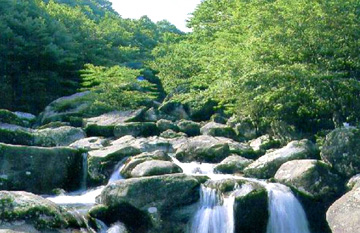
This valley has been long renowned or its gorgeous scenery. It is said that Goun Choe Chi-won, a renowned Confucian scholar and poet, after wandering through Jirisan Mountain, stayed here in this valley because of its beauty.
The region was named “Goun-dong” after “Goun,” which was the nom de plume of Choe Chi-won. Among the slopes and forests of Jirisan Mountain, there are several sites associated with the biography of Choe Chi-won such as Okcheondae, Munchangdae, Seiam, and Hwanhakdae, we find artifacts with what is known to be Choe’s own handwriting—including the Stele for Master Jingam at Ssanggyesa Temple, the Stone Gate in Ssanggyesa Temple, and Gwangjeammun—but Goun-dong is the only instance in which a place was named after this beloved Confucian scholar. This is probably indicative of the appreciation people have had for the scenic beauty of Goun-dong.
Perhaps because of the legend that Goun became a mountain spirit guarding Jirisan Mountain, many Koreans associated Goun-dong with a kind of utopia named “Cheonghak-dong,” an ideal world free of war, full of good food, and where privileged and the commoners both live long, healthy lives without any class division. In stark contrast to this idyll, however, Gyeongsang-do and Jeolla-do, located at the foot of the Jirisan Mountain, has been the site of numerous social upheavals and war, testifying to the exploitative practices of Korea’s ruling classes in the past.
To get to Goundong Valley, travel from Deoksan in the direction of Jungsalli and continue a little past the sign post for Jeonggaksa Temple in Oegong-ri and enter the valley by following the signs guiding visitors to Soji Farm. After you cross the valley stream that flows down from Jungsalli and before you enter Bancheon Village, you’ll find yourself in a small valley with a broad hillslope where you can imagine there might once have been a village. This is characteristic of the landscape of Goundong Valley, and you’ll have a similar experience when you go past Baebawi Rock and reach the road that leads to Goun-dong: though the area may appear narrow at the mouth of the valley, once you enter the basin that located higher than the valley, at an altitude of around 800m above sea level, you’ll find a landscape that is broad and welcoming and looks as though it may have once been the site of a village.
You’ll begin to taste the true flavor of Goundong Valley once you reach Baebawi Rock, where the stream that flows down from Pirigol Valley converges with the main flow of the Goundong Valley. This area is crowded with vacationers in the summer, and there are camping grounds scattered here and there throughout the valley. If there is a sudden rainfall, however, the stream is prone to overflow quickly, and therefore vacationers must take much caution when camping overnight, rather than simply vacationing in the daytime. Moreover, in this valley there are many inviting flat-topped rock formations (called “Neoreokbawi Rock”) such as Baebawi Rock, which are great spots to sit and spend time with loved ones, enjoying the view of colorful fall foliage in the valley and the leaves floating downstream on the water.
Because of these scenic delights, some hikers claim that the trail from Bancheon Village to Goun-dong, though only 5km or so in distance, takes all day to enjoy properly. Once you walk past Yunyeo Falls, which is thus named because the water sprays rise like a white cloud, you reach the Neoreokbawi Rock named Baebawi Rock. Climb on top of Baebawi Rock, which is around 20m long and 10m wide, and you’ll be rewarded with a grand sweeping view of the valley below. Standing on top of Baebawi Rock, gazing down at the crystal clear water endlessly flowing in a meandering path through the rocks, one has the sensation of hearing the foghorn of a departing boat. At the point that would correspond to the prow of this imaginary boat, you’ll find the phrase “Juamdae” inscribed in the stone.
In Goun-dong, one can still find a “sanbang” where you can taste tea grown in Jirisan Mountain and a home that is the residence of people who practice discipline and meditation, dreaming of an idyllic world. Most hikers climb through Goundong Valley up to Goun-dong and indulge in a cup of tea at the sanbang, and then descend through Pirigol Valley along a trail that connects to Baebawi Rock at the entry. Pirigol Valley offers hikers a series of small delights, and remains relatively sheltered from the influx of crowds.
The name of Pirigol Valley (which means “flute valley,”) also has associations with the Confucian scholar Choe Chi-won. When Choe Chi-won was in Goun-dong, he is said to have enjoyed taking walks through this trail while playing the flute.

The picturesque scenery of Naewonsa Valley seems straight out of a Silgyeong Sansuhwa (Real-scenery landscape paintings). In the springtime, the scent of awakening nature, along with the aromas from the Buddhist temple, wafts up through the valley and seems to purify this earthly world of suffering. In the summer, the lush greenery and the energetic roar of water flowing through the valley chases away the heat. In the autumn, even before the sunset, the fall foliage dyes the skies and the streams a deep crimson.
When winter comes, the mountain ridges are pristine white and one can hear the tingle of wind chimes and the percussive taps of the wooden “moktak” of the monks – ceaseless sounds that seem to voice a longing to awaken the essence of the universe. Naewonsa Valley simultaneously encompasses the tragedy, the serenity, the grandiosity, and the depth of Jirisan Mountain.
It was here in Naewonsa Valley that the last wartime partisan holding out in Jirisan Mountain was apprehended. The valley also has around ten hermitages. This area is located in the middle of the mountain range that extends from Gugoksan Mountain to Guksabong Peak and on to Sseoribong Peak, Jungbong Peak and Cheonwangbong Peak, and the lengths of the two axes of the valley, Naewongol Valley and Jangdangol Valley, extend around 50km.
Naewonsa Valley, which begins in Daepo-ri, Samjang-myeon, Sancheong-gun splits into Naewongol Valley and Jangdangol Valley in front of Naewonsa Temple. Where the road splits, you can choose to go in the direction of either Naewongol Valley or Jangdangol Valley, but if you are the type who especially values first impressions, we recommend that you head straight in the direction of Jangdangol Valley. Here, you’ll not only be greeted by a forest at the entry, but also find incomparable scenic views around Banyagyo Bridge which spans the stream which branches and flows down from Jangdangol Valley. Standing atop Banyagyo Bridge, you’ll feel cold in the chill, crisp air of the valley even in the summer, while admiring the curves of the water as it glides between the scenic rock formations.
Naewonsa Temple may appear small in scale, situated in the grandness of Jirisan Mountain, but it appears to have an elegant dignity befitting a temple that has weathered a millennium of history. First, there is the gracefulness of the three-story stone pagoda, which has retained its appearance throughout centuries of exposure to the elements, and which gives the dynamic impression of the valor and devotion of Buddhist monks. The sculpture of the Buddha, (named “Birojana Seokbul”) which is seated inside Birojeon Hall, has an expression full of compassion that seems to signify the generous spirit of Buddhism toward mankind. This temple offers us great examples of the aesthetic style of stone pagodas and Buddha statues in the 8th century, a period when Buddhist culture flourished in our peninsula.
Circle around the temple and exit in the direction of the bamboo grove, and you’ll find yourself on the way to Naewon Village. While there is no residential village within Jangdangol Valley, Naewongol Valley is home to both Outer Naewon and Inner Naewon villages.
Naewon Village is famed for its persimmon trees and handcrafted lucky bags. The dried persimmons are a local speciality, made from the persimmons that are raised year-round in Sicheon-myeon and Samjang-myeon, and the so-called lucky bags are a handicraft that originated in this area. The local dried persimmons are popularly considered a delicacy because Naewon Village is located at such a high altitude and the air is pristine and unpolluted. The “lucky bags” are also weaved from the bamboo that one finds in abundance in the Jirisan Mountain region and allows residents to add to their income with their handiwork. From autumn to winter, the preparation of dried persimmons and the weaving of bamboo lucky bags keep the locals busy. Life in Naewon Village, however, was not always so idyllic and peaceful. This village is where Lee Hong-i, a historical figure regarded as the last wartime partisan of Jirisan mountain and famed as a one-man-troop, was killed, and this was also where Jeong Sun-deok was captured alive after having his foot shot with a gun.
Naewon Village, positioned in the depths of Jirisan Mountain, has been exposed to the historical vicissitudes and tragedies of this region. Perhaps because of this, Naewongol Valley has many Buddhist temples. There are around ten small hermitages along the Naewongol Valley, as though intended to console the souls of the residents, whose painful memories run as deep as the valley. Naewongol Valley had been home to many Buddhist temples in past eras as well. The valleys above Inner Naewon Village are called Keunjeolgol and Jakeunjeolgol and the seated Buddhist sculpture (named “Birojanabuljwasang”) found in Naewonsa Temple was relocated there from an area near Guksabong Peak in the upper reaches of Naewongol Valley. Naewongol Valley itself can thus be considered to be Jeolgol.
Jangdangol Valley, which forms a single axis with Naewonsa Valley, is beloved among hiking aficionados as the last hidden scenic site of Jirisan Mountain. Since the development of accessible hiking trails in Jungsalli and in the direction of Daewonsa Temple, this area has by contrast become less frequented by visitors and thus Jangdangol Valley has been able to preserve the primal beauty of Jirisan Mountain. Jangdangol Valley is not easy for casual visitors to reach. There is a broad road leading from the front of Naewonsa Temple to Gyeongsang National University’s research forest, while from the direction of Daewonsa Temple, it is easy to go as far as Mujechigi Falls.
Jangdangol Valley originates from Sseoribong Peak and Mujechigi Falls, at an altitude of 1,000m above sea level, is tucked away at the foot of Chibatmok Mountain Villa. The name of the waterfall, “Mujechigi,” is an abbreviation of a Korean phrase which means “rainbow-building,” and refers to how the fall appears to create its own arches of rainbows. It forms three levels, cascading down a giant stone cliff rising around 40m. In the uppermost level, the water falls in three streams, which splits into 8 streams in the second level and finally merge into two streams in the third level. Because the falling water thus falls in multiple strands, they sound as musical as piano keys or an ensemble of instruments, creating varying symphonic sounds depending on the water volume. There is a legend that the musical innovator Ureuk invented the gayageum (a Korean musical instrument with twelve strings) by listening to the sound of the waterfall here and plucking strings that he hung from a tree.
Once you come down from Mujechigi Falls, you’ll find yourself in a forest that is said to be populated with around 2,200 nut pine trees. Unlike other valleys where you’ll find a miscellany of various trees and scrubs, here you’ll be impressed by the view of trees that soar straight up, nearly obscuring your vision of the sky, and the stream that flows forcefully, filling the valley with its roar. Once you visit this site, you’ll understand why Jangdangol Valley is referred to as the best kept secret in Jirisan Mountain.
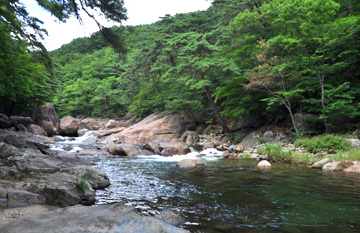
Daewonsa Temple, which is located in the Yupyeong Valley north east of Jirisan Mountain’s Cheonwangbong Peak, is considered to be one of the top three sites for the meditative practice of Buddhist nuns, along with Sudeoksa Temple and Gyeonseongam Hermitage. The temple was founded by a renowned priest named Yeongi Josa under King Jinheung of Shilla, and was partially restored multiple times after destruction from fires. At the time of the Yeosu-Suncheon Rebellion, the entire temple burned down due to the incendiary tactics used by wartime partisans, and the temple was rebuilt in 1955 by Monk Beopil.
Daewonsa Valley has an enchanting, mystical beauty formed by the lush and deep forests and the broad stone formations. Originally, it was called Yupyeong Valley, after the name of the local village, but it is now referred to as Daewonsa Valley in homage to the purifying image projected by the Buddhist nuns of Daewonsa Temple.
The Yupyeong-ri course, which leads from Chibatmok Mountain Villa in Bambatgol past Habong Peak and Jungbong Peak and up Cheonwangbong Peak, takes around 5 hours and 30 minutes to complete. The water flowing through Daewonsa Valley originates from several spots of the mountain range that runs from Jirisan Mountain‘s Cheonwangbong Peak through Jungbong Peak and Habong Peak and onwards through Ssukbatjae Pass, Saejae Pass, Wangdeungjae Pass, Bammeorijae Pass, and Ungseokbong Mountain and this body of water flows along a valley that stretches 12km. The valley stream, which converges through Sinbatgol, Jogaegol, and Bambatgol, gathers volume as it passes through Saejae Pass and Oegok Village, and forms an impressive body of water once it reaches Yupyeong-ri in the district of Samjang-myeon, Sancheong-gun, which is the location of Daewonsa Temple, home to Buddhist nuns practicing Zen meditation.
The valley has several “Yongso” with names such as Seonnyeotang and Ongnyeotang and other basins such as Sesindae and Sesimdae. The rocks are caressed with water ceaselessly, day and night all year round, and thus have a brilliantly clean, polished sheen. In the summer, Daewonsa Valley, which runs 12km long, is full of vacationing crowds. It is an incomparably beautiful spot in which to indulge in the scenic bounty of nature.
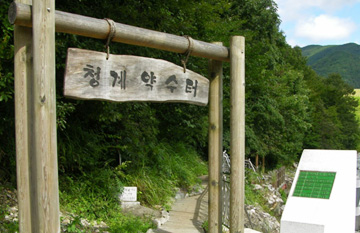
Within the Jirisan Mountain region, Baegundong Valley is the area that has the strongest associations with the renowned scholar Jo Sik, whose pen name was Nammyeong. Throughout this area, one finds stone inscriptions of phrases such as Baegundong, Yongmundongcheon, Yeongnamjeilcheonseok, and Nammyeongseonsaengjangjiso that are purported to be by the hand of Nammyeong. This is also the setting where Nammyeong is said to have composed the work which includes the following quote: “Now that I have climbed the green mountain, the whole world is of cerulean hue, but the greed of mankind knows no end, and thus our heart lusts for worldly affairs even while gazing on the beauty of the landscape.”
Despite being called to serve in the royal court, all his life Nammyeong chose not to seek a career in government, and instead secluded himself in the greenery of Jirisan Mountain, teaching his disciples. During the Japanese Invasion of Korea in 1592, it was his pupils who became leaders of the “Uibyeong” (an army raised in the cause of justice) in greatest numbers. His writings, penned here in Baegundong Valley, portray the true visage of the school of the “scholars of the mountains and forests” who turned from worldly greed and immersed in learning amid the beauty of nature.
To get to the mouth of Baegundong Valley, drive along National Road 20, which runs through Uiryeong-gun, Sancheong-gun, Sicheon-myeon, Jungsalli, then drive 1 km further past the Chiljeong Samgeori which splits into Okjong-myeon, Hadong-gun and then follow the sign that says Baegundong Valley.
Waters from Ungseokbong Mountain flow along the lengthy slopes of Unsan Mountain and rush into the Deokcheongang River in an area that is known as Baegundong Valley. Ungseokbong Mountain is positioned in the middle of Gyeonghogang River and Deokcheongang River, demonstrating the truism that “a river cannot cross a mountain, and a mountain cannot cross a river.” The waters of Eocheon Valley and Cheonggye Valley flow into the Gyeonghogang River while the waters of Gyerimjeong Valley and Baegundong Valley become tributaries of the Deokcheongang River.
While traveling along the valley, once you reach Jeomchon Village, Sancheong-gun Danseong-myeon, Baegun-ri while traveling along the valley, you’ll encounter the refreshing sight of the valley stream, a curiously shaped precipice with the phrase “Baegundong” inscribed in the stone, and a broad float rock foundation with the phrase ‘Yongmundongcheon’ engraved into it. Above, you’ll find a basin named “Dajiso” according to legend, you’ll obtain enlightenment just by bathing in this water. The basin is 26m wide and 30m long and is surrounded by rocks, making it a popular spot for summer vacationers escaping the heat. Furthermore, the valley also includes the Baegun Falls, which falls from a height of 4m, and Odam Falls, which means “five ponds” and refers to the five cascades and ponds that constitute this formation. Deungcheondae is another scenic spot where the phrase “Yeongnamjeilcheonseok” has been engraved in the stone and where the valley waters rush upward with great vigor, as though reaching for the skies.
The valley is dotted with numerous basins in the valley including Cheonguiso— which means “listen only to righteousness”-- Ahamso, Janggunso, and Yongso, as well as many cascades such as Talsok Falls, Yongmun Falls, Sipodam Falls, Chilseong Falls, and Suwangseong Falls. Here, where we can trace the footsteps of Nammyeong, the moral leader of scholars in the Joseon Dynasty, the valley invites us to reflect on the sense of plenitude that was enjoyed by the scholars who practiced the principle of “being content amid poverty and taking pleasure in acting in an honest way.”
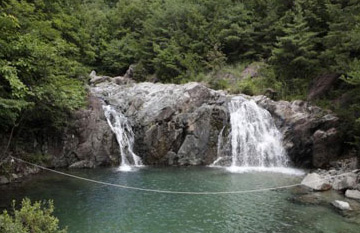
According to Korean mythology, beautiful celestial women called “seonnyeo” once descended from the sky to frolic here, and legend also has it that scholars of yore used to come here to test their own learning. Seonyudong Valley is located behind Suwol Village in Sancheong-gun, Sinan-myeon, Anbong-ri. Drive along National Road 3, which runs from Jinju to Sancheong-eup, and you’ll pass Docheonseowon Confucian Academy, which commerates the life of Samudang Mun Ik-jeom, a historical figure famed for being the first to import the cotton plant into Korea. At the first village past Docheonseowon Confucian Academy, turn right in the direction of the old Wolseong Elementary School and you’ll find yourself in Suwol Village, at the entry to Seonyudong Valley.
In the past, Sancheong was home to many of the scholarly elite class, and for this reason, Seonyudong Valley exudes elegance reminiscent of the literati who once composed poems while floating glasses of wine on the flowing waters of the stream.
The name Seonyudong means the place where seonnyeo –mythical celestial women—descended to earth to play. According to this myth, one can still find two stone vases in the valley where the seonnyeo made and stored their wine during their earthly visit. If you look closely at the gigantic flat stone that lies at the top of the waterfall, you’ll find large holds around 50cm in diameter and 2m deep, which look like large wine vats. Perhaps the literati of centuries gone by composed poems at Seonyudong, invited the celestial seonnyeo, and dedicated their peoms to the heavens, or perhaps they tempted the seonnyeo with the aroma of wine.
Suwol Village, which is always vital with the greenery of bamboo and pine, is as picturesque as can be expected of a village located just below the famous scenic site where celestial seonnyeo came to play. Walk along the valley stream that flows in front of the village for around 1 km, and you’ll find Suwol Falls, hidden deeply inside the stone face. Although the volume of water is not great, it falls from a height of around 15m and the cascade appears as elegant as the folds of a lady’s skirt.
The basin where the fallen water pools is very deep: old folks used to say that that you won’t reach the bottom of the pool even if you unravel three spools of silk thread. The dense pine forest which surrounds the basin gives the site a certain mystique. Above the rock formation of the waterfall, there are traces that are attributed to a mythical dragon. According to this myth, as the dragon gradually ascended to the heavens, he stepped slowly along the rocks on the two sides and his claws left two long groves in the rock. It is a delightful myth that expresses the wondrousness of Seonyudong’s beauty.
To find the valley that gives Seonyudong its name, one must go 1km further beyond the waterfall. The story about the stone vats where seonnyeo made their wine, or the natural groves in the stone identified as the traces left by the feet of seonnyeo as they danced after a glass of wine—such colorful local lore attest to the joyful spirit of the Korean people, who have always taken delight in song and dance along with good wine and food.
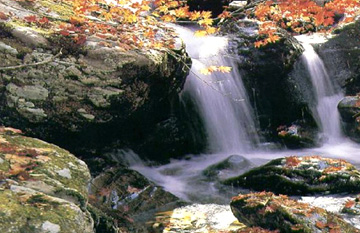
Eocheon Valley, located at the foot of Ungseokbong Mountain, branches out from Gyeonghogang River. Although small in scale and volume of water, the valley is a clean and quiet spot beloved by summertime visitors.
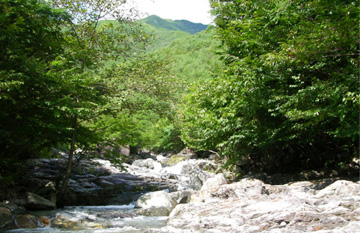
Among the numerous mountainous valleys in Sancheong, along the eastern ranges of Jirisan Mountain, Obong Valley is one of the few that seems to have maintained much of its original natural state. This site forms a valley in the shape of a funnel between what is called the “white tiger” and the “blue dragon” according to Feng Shui beliefs. The view of the valley when gazing down from Obong-ri is stunning but remains relatively serene compared to other tourists sites that become overwhelmed with vacationers in the summertime.
The name if the valley, “Obong,” either refers to the five mountain peaks seen to the north of the village, or to the five mountain slopes that stretch down toward Obong and the village.
Although historically, Obong-ri was home to the prosperous and illustrious Kim clan of Gyeongju, today there are only about ten households residing here in proximity to one another. One can’t help but admire the picturesqueness of the streams of water flowing from both left and right, merging into a single flow and the poignant solitude of the village, tucked away by the basin in the mid-to-upper reaches of the valley.
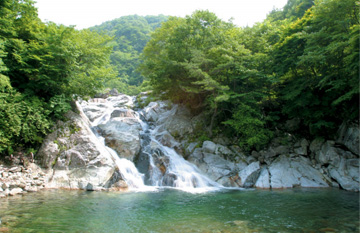
Deokcheongang River originates in Sancheong it is a river believed to cleanse the local spirit of Sancheong, a river that retains the patriotism embodied in the temples erected in the Shilla and Goryeo Periods in honor of the guardian spirits of the nation, a river that reminds us of those locals who opposed the opening of Joseon to modernity and the mystical beauty of the mountain itself.
Famed locations include Cheonwangsaem Spring which bubbles up from under Jirisan Mountain’s Cheonwangbong Peak, Jeseokcheon, where our ancestors honored the spirits of Jirisan Mountain, Eumyangsusaem Spring, associated with the legend of the childless couple Hoya and Yeonjin, Mujechigi Falls, where the water that followed from Eumyangsusaem Spring and down through the Jungsalli Valley is said to make its own rainbows, and the serene Daewonsa Temple, where one can hear the calm chanting of pure-hearted Buddhist nun. From Deokcheon Yangdansu, where the water that has flown down from the temple converges, all the way down to Jinyangho Lake, this grand mountain has many stories of sorrow to share.
Yangdansu is the point at which the waters that have flown down Jungsalli Valley meet the water from Daewonsa Valley. Our ancestors referred to this place as paradise: how clear the water and how delightful the scenery must have been for it to have deserved to be called utopia? Nammyeong, a renowned Confucian teacher, refused to accept a position in the royal government all his life and instead resided near Yangdansu, with views of Jirisan Mountain, where he established Sancheonjae and taught Gyeonguihak, a school of thought that emphasizes the values of “disciplining the heart inside and practicing righteousness outside.” Past Deoksan, the water that comes from Mageundam below Ungseokbong Mountain is increased by the water of Jungtaecheon Stream, which flows through Galchijae Pass from Deoksan and over Hadong, nourishing Jayangdeul. The abundant water of Deokcheongang River and the enriching sediments that flow down from Jirisan Mountain ensure that always remains fertile.
Jayangbo Reservoir, which was dammed in order to send water to Jayangdeul, is a natural recreational site that bustles with vacationers in the summer. Below Jayangbo Reservoir, the Baegun Valley contributes its water and the river finally flows toward Okjong in Hadong. Deokcheongang River, which passes through Okjong, goes through Sugok, Jinju, flows into Jinyangho Lake, merges with Gyeonghogang River, which has passed through Sancheong-eup, flows into Namgang River, and again converges with Nakdonggang River which originated in Taebaek Hwangji of Gangwon-do, thus completing the 200km long journey of Namgang River.
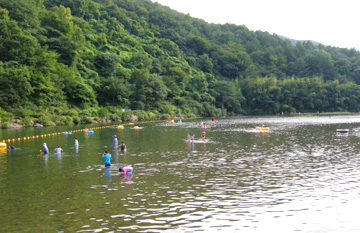
Cheonwangbong Peak, which is the highest peak in all of Jirisan Mountain, forms the valley named Jungsalli Valley. The name Jungsalli, which means “middle,” indicates that this valley is located around the middle of Jirisan Mountain, and has long been used as a starting point for many hikers of Jirisan Mountain. It has been recorded that many scholars of past eras, including Kim Il-son, Jo Sik, and Lee Ryuk, climbed up to Cheonwangbong Peak from Jungsalli Valley: perhaps most well-known is the story about Kim Jong-sik, who is said to have climbed Jirisan Mountain 500 years ago with his horse, his servants, and his pupils.
As can be expected of a valley that has thus attracted people for centuries, and as befitting the honor of being the original site of Deokcheongang River, which flows into Namgang River and onwards into Nakdonggang River, this valley boasts outstanding scenic beauty. Go past the park admission ticket booth and take the path located to the site of the stone memorial for Heo Man-su—who is being honored for having pioneered contemporary Jirisan Mountain hiking trails—and you will enter Beopcheongol Valley, which is the main hiking trail toward Cheonwangbong Peak and one of the main valleys that form Jungsalli Valley.
Beopcheongol Valley, which begins at Sanhuisaem, located immediately below the Jangteomok Pass (1,750m above sea level), encompasses Beopcheon Falls, Yuam Falls, and Mumyeong Falls as well as various pools and basins. Thus the sounds of the moving water can range from the grandeur of a symphony to the intimacy of chamber music.
It is located at a 9km distance respectively from Jungsalli on the Sancheong side and Baegmu-dong on the Hamyang side, and when hiking with a heavy load on your back, you won’t feel you’ve lost out by choosing either side. Regardless of whether you chose the Jangteomok Pass or chose to climb Beopcheongol Valley from Sancheong or Hansin Valley from Hamyang, you’ll be sure to appreciate the cool greenery in the summer and admire the autumn leaves that fill the valley in the fall.
Sunduryu Valley is one of the branches included in the Jungsalli Valley. Sunduryu Valley is accessible by car along the road leading from the Jungsalli ticket booth. The valley’s name, “Sunduryu,” comes from “Duryusan Mountain,” which is an alternative name for Jirisan Mountain. The name “Sunduryu” was intended to mean that Duryusan Mountain has sloped gently and has formed a flatland. It is said that in decades past, the plain that starts in Sunduryu Valley was home to slash-and-burn farmers, but today it is the location of the Gyeongsangnamdo Environmental Training Institute. You can reach Sunduryu Valley by car, since it is also the location of the Gyeongsangnamdo Environmental Training Institute, but the entry of recreational vehicles are regulated at the ticket booth.
The stream that originated somewhere between Cheonwangbong Peak and Jungbong Peak gathers volume as it passes through Yongchu Falls and once it merges with the water that flows from Sseoribong Peak, the stream begins to roar and presents itself in breathtaking scenery. Even just 10 years ago, the valley was frequented by people who came to perform devotional prayers, so that drips of candle wax, still moist, could be found on nearly every flat-surfaced rock (called “Neoreokbawi Rock”). Not only was the valley beautiful, it was believed that the vital forces of the mountain that flowed from Cheonwangbong Peak were very potent at this site and helped make the prayers come true. Perhaps there is some truth to the claim that Sunduryu Valley is a place of beneficial forces: this was once considered highly desirable land for cultivating ginseng. Once armed partisans took over the area during wartime, however, ginseng farming quickly declined, and these days the land only yields the occasional wild ginseng root to the passerby.
One caveat is that in order to truly enjoy Beopcheongol Valley and Sunduryu Valley, you ought to come prepared with mountain hiking gear. If you are visiting Jungsalli Valley with a plan to stay briefly for a day enjoying nature, instead of hiking we would recommend simply finding a lovely spot on the roadside between Deoksan and Jungsalli where you can gaze leisurely on the flowing water and enjoy the rare opportunity to be in each other’s company and share conversation with your family.
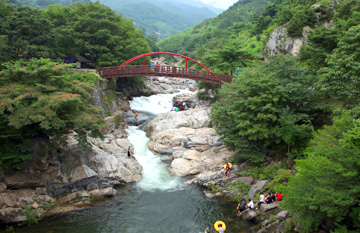
Jimak Valley, located in Jimak-ri, Geumseo-myeon, Sancheong-gun, Gyeongsangnam-do, has a scale of 45.000m and is positioned at the point where the slope descends into flatlands, over the Bammeorijae Pass. This recreational area is in the heart of the forest, where the valley is full of clear water, and it attracts crowds of vacationers each summer. After climbing for quite a while, you’ll finally arrive at the valley, where the stream is refreshing and invitingly cool.
Along with the primal natural forest, here you can also see faint traces of the sites of houses and fields where farmers trying to make a livelihood using slash-and-burn techniques lived even up to just three decades ago. In addition, you can admire Cheonjibawi Rock and the scenic beauty of pine trees growing on the stony landscape, forming an aesthetic similar to the mountainous scenery in Huángshān, China. At the end of the valley, there is a temple called Cheongwangsa Temple.
Nearby attractions include Wangsan Mountain, Pilbongsan Mountain, Ungseokbong Mountain, Royal Tomb of King Guhyeong, Deogyangjeon Hall, Cheonwangsa Temple, etc. Since there is much for visitors to see in the vicinity, it’s a vacation spot where you can catch two birds with one stone and experience the diverse facets of Sancheong. Bring the whole family and join your children in the game of catching marsh snails called “daseulgi”, observe living fish and damsel flies in their natural habitat, and learn about the environment. Use your hard-earned summer vacation to catch up with friends; leave the city behind, breath deep in the fresh air, and let go of your stress while immersed in nature. Spend a romantic date with your loved one, exchanging sweet words while making long-lasting memories.
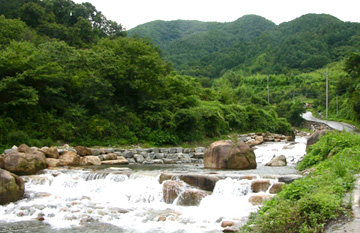
This is a natural recreational area that attracts many visitors during the summer vacation season. The site is equipped with convenient parking spaces, camping facilities, bathrooms, and water facilities.
The valley is of a cozy size, and Sonhang Reservoir is located near the mouth of the valley. Hwangmaesan Mountain and Buamsan Mountain are also in the vicinity.
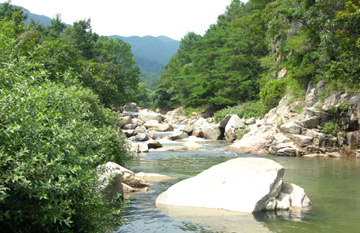
Cheonggye Valley is a true palimpsest of history: here you will find menhirs, which are remains from the prehistoric ages, the Dansoksa Temple Site where a stone pagoda that has weathered the vicissitudes of a thousand years still remains standing, an apricot tree (Jeongdangmae) that boasts an age of around six centuries and still blooms in the spring, and a stone grave positioned at the peak of a mountain pass that legend attributes to a woman who died after suffering tragically at the hands of her oppressive in-laws. This is a valley full of attractions and lore, which has now been well-developed for easy access by car. The name of the locality, such as Cheonggye and Dansok, carry uncommon significance.
How impressed people must have been at the pristine state of the valley to name it “Cheonggye,” which means “clear valley”? How deep and insulating the valley must have seemed, to name it “Dansok,” which means cutting oneself off from worldly affairs? As soon as you arrive at Namsa Village, which is at the mouth of the Cheonggye Valley, you will sense the serene, solitary atmosphere. From Baeyang Village, where cotton was first cultivated, proceed in the direction of Jungsalli for 4㎞ and enter Namsa Village: there, you’ll perceive the dignified lifestyle once led by the “yangban” ruling class of the Joseon Period, observing the “sotseuldaemun”, which stands tall in front of a local style of home with an endearing earthen work fence, 40 or so traditional style houses that exude elegance from their tiled rooves, and the forest that surrounds the neighborhood.
Past Namsa Village, you’ll find signposts above Hoamgyo Bridge guiding you to Ungok Farm, Dhamul Lifelong Education Center, etc. Follow these signs, and you’ll be inside Cheonggye Valley. Once you enter the valley, you’ll find yourself inside Ipseok Village. The menhir that stands around 2m tall in the campus of Ipseok Elementary School dates from the prehistoric era, testifying to the immemorial long history of Cheonggye Valley. Next, you’ll come to a giant rock engraved with the phrase “Gwangjeammun”: you have now arrived at the valley.
It is easy to miss, since it is a bit out of the way from the road. This is where Dansoksa Temple begins; this site is ideal for resting, with spaces suitable for a cozy camping experience with your family, and there are also guest houses offering accommodations along the road. The ancient Dansoksa Temple, which was established during the Shilla Period, currently houses a three-story stone pagodas designated as National Treasure 72 and 73; it is said that this temple once held other invaluable works such as a portrait of King Gyeongdeok, the work known as “Yumasang” painted by the renowned Solgeo, and 500 or so stone Buddha sculptures, each unique in appearance.
At the Dansoksa Temple Site, a locality also known as “Tapri”, in reference to the presence of a stone pagoda in the village, one hint of the grand scale of the ancient temple that was once here is that the flagpole supports are situated far away from the stone pagoda. If you move past the flagpole supports and climb to the front of the stone pagoda you’ll find two pagodas positioned in alignment east to west, which have not lost their grace even after a millennium. The simple chiseled elegance of the stone pagoda, without any embellishing frills, seems to express the vicissitudes of the past centuries. The bamboo grows straight and upright in front of the stone pagoda as though guarding the pagoda; behind the pagoda, there is an apricot tree known as “Jeongdangmae” and a small building housing a monument, each of which are associated with legendary lore.
As regards the Jeongdangmae, it is said that when Gang Hoe-baek was a youth studying at Dansoksa Temple, he planted this apricot tree, and the tree was given its name because once Gang passed the governmental examinations, he was appointed to the position of Jeongdangmunhak (chancellery scholar). During the Joseon Dynasty, Kim Il-son noted in the book 『Sok Duryurok』 that when he “leaned against the banister of the tall pavilion and gazed down to the front yard, he saw an apricot tree with its branches wide open, and this tree was known as Jeongdangmae.” Based on this description, it appears that Daeungjeon Hall and the tall pavilion were located behind the current position of the pagoda. At the present, residential houses occupy the site of the ancient Buddhist sanctum, and stone clearly inscribed with lotus flower patterns are used to stack stone fences or as a post on which the dog’s leash is secured. Such sights make one reflect poignantly about the futility of human endeavors over time, and the melancholy outcome of indifference.
Circling past the pagoda, climb up the valley path: to your right, you’ll see a valley that is cherished as the best in all of Cheonggye Valley. In the summertime, you’ll likely seen tents leaning against the shadow-casting pine trees, which grow stoically between the rocks and appear to be the remnants of the vanished temple. This valley is truly beautiful; perhaps this is the reason that Cheonggye Valley came to deserve the name, which means “clear valley.” Across the broad span of the stream, there is an open space formed by little stones, the water is crystalline, and rises only up to an adult’s knees: it is thus the optimal spot for playing in the water.